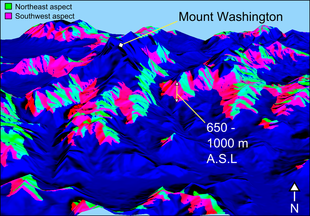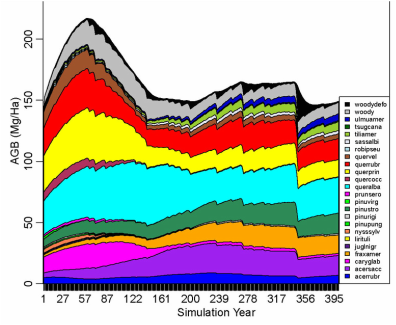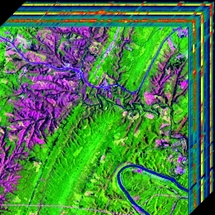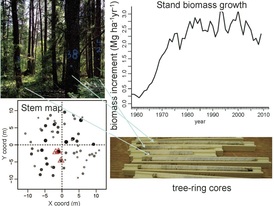RESEARCH
CHANGES IN MONTANE FORESTS & BIRDS
Ecotones are transition zones that are often vulnerable to climate change. In temperate zones, I use the landscape simulation model, LANDIS-II, to predict forest change under different climate scenarios. To inform our simulations, we developed new geospatial methods using DEMs and Landsat imagery to quantify ecotone shifts. Our most recent findings revealed that montane forests in New England have not receded upslope as expected, but rather have expanded downslope over the past 27 years (Foster and D’Amato (2015) Global Change Biology).
|
_ |
FOREST RESPONSE TO DISTURBANCEMy doctoral research explored how insect defoliation affects above-ground forest carbon. I used forest inventory data and remote sensing to characterize outbreaks (Foster et al. 2013 Landscape Ecology), and developed a landscape model to simulate changes in carbon that accompany invading insect populations. I used MODIS data to demonstrate that synchrony between phenology of host tree populations and defoliating insects drives disturbance patterns (Foster et al. 2013 Forest Ecology and Management). I continue to collaborate and improve this insect disturbance model as it is applied by others in new systems.
|
MAPPING FOREST STRUCTURE & FUNCTION
Much of my research focuses on developing innovative quantitative tools from GIS, remote sensing and field data to examine forest ecosystem function. This includes developing methods for analysis of hyperspectral and radar data to map forest communities (Foster and Townsend 2004), disturbances (Townsend and Foster 2002, Townsend et al. 2012), and the biogeochemistry of forest canopies (Townsend et al. 2003).
|
CLIMATE EFFECTS ON TREE GROWTH & FOREST C
Tree-ring data help us understand past climate change, yet there is considerable confusion about appropriate statistical models to use when estimating future forest change (Foster et al. 2010 PNAS). Some of my current work seeks to clarify these issues. I used tree-ring data from 3000 mapped trees to reconstruct mortality and aggregate growth, providing insights that improve forest models (Foster et al. 2014 Oecologia). I collaborated with statisticians to develop Bayesian models of individual tree growth that account for both spatial and temporal autocorrelation. These models show that tree size and age account for more variation in growth than annual climate, a finding with significant implications for global vegetation and C-cycle models (Foster et al. (2016) Global Change Biology).
|
COLD-AIR POOLING in NORTHEASTERN FORESTS
Cold air is known to develop and pool in mountain valleys or topographic depressions in complex terrain. This process is believed to occur most often at night and under clear skies, yet its frequency and seasonal occurrence have not been widely measured. Forest species, plants and animals, are affected by temperature regimes that are changing as the climate warms. We are working to characterize the frequency and geographic variation in cold-air-pooling for watersheds (red polygons) in the northeastern US from a combination of satellite data that measures land surface temperature (MODIS LST), meteorological station data, and co-located microclimate sensors on elevation transects across the region (black dots). Cold air pooling can be seen in these night-time MODIS LST images, where cooler (bluer) colors show colder temperatures in low-lying areas on 2015-11-05.
Proudly powered by Weebly



